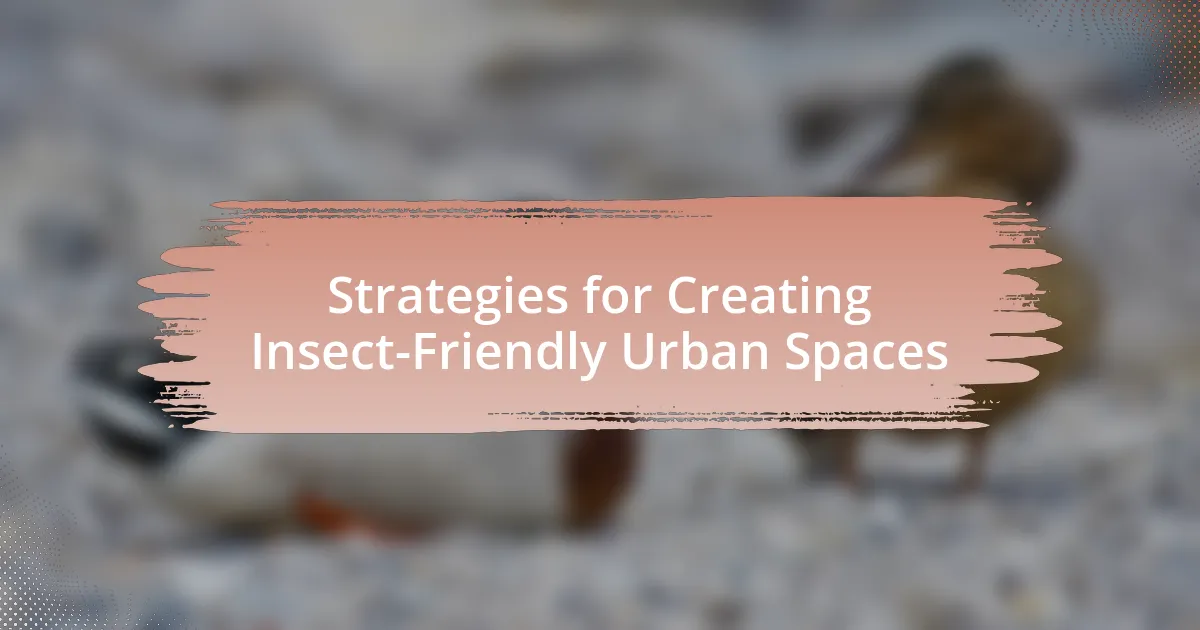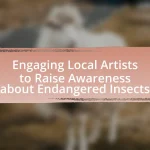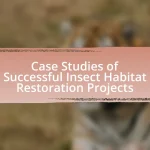The article focuses on strategies for creating insect-friendly urban spaces, emphasizing the importance of incorporating native plants, reducing pesticide use, and designing green infrastructure. It highlights the critical role insects play in urban ecosystems, including pollination, decomposition, and pest control, while addressing the challenges posed by urban environments that disrupt natural habitats. Key principles of insect-friendly urban design are outlined, such as creating diverse habitats and integrating biodiversity into urban planning. The article also discusses community involvement and educational programs as essential components for fostering awareness and participation in insect conservation efforts.
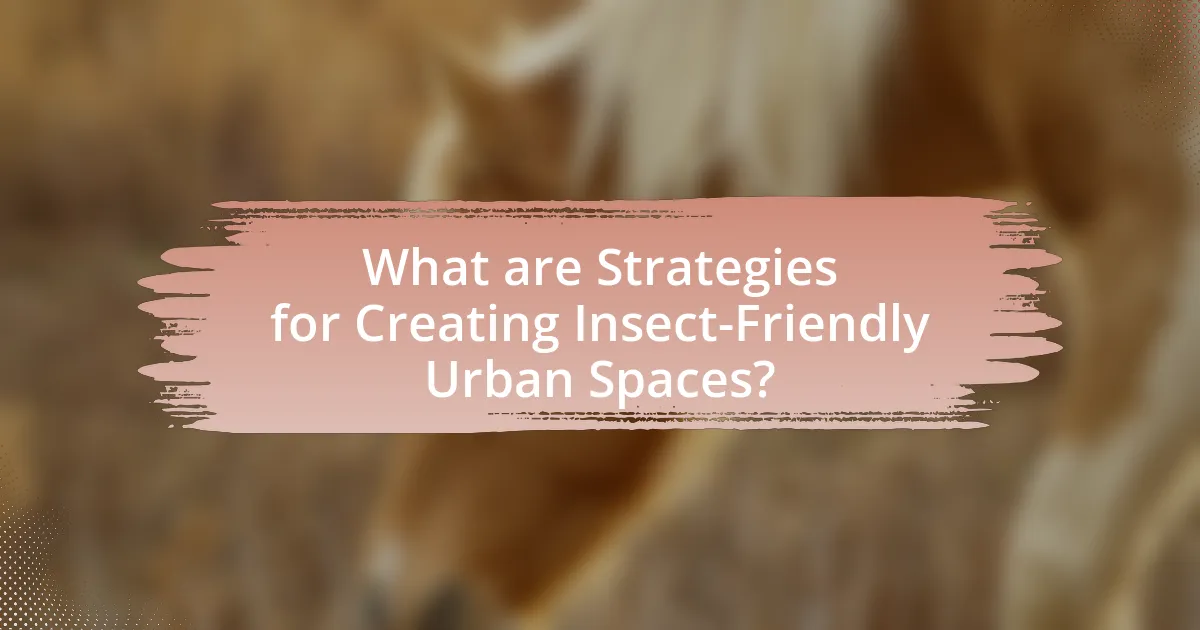
What are Strategies for Creating Insect-Friendly Urban Spaces?
Strategies for creating insect-friendly urban spaces include incorporating native plants, reducing pesticide use, and designing green infrastructure. Native plants provide essential food and habitat for local insect populations, supporting biodiversity. Studies show that urban areas with diverse native flora can increase insect abundance and species richness. Reducing pesticide use minimizes harmful impacts on beneficial insects, promoting healthier ecosystems. Additionally, green infrastructure such as rain gardens, green roofs, and pollinator pathways enhances connectivity between habitats, allowing insects to thrive in urban environments. Implementing these strategies can significantly improve urban biodiversity and ecosystem health.
Why is it important to create insect-friendly urban spaces?
Creating insect-friendly urban spaces is crucial for maintaining biodiversity and supporting ecosystem services. Urban areas often disrupt natural habitats, leading to declines in insect populations, which are essential for pollination, soil health, and pest control. For instance, studies show that urban green spaces can enhance insect diversity and abundance, contributing to the overall health of urban ecosystems. Additionally, insects play a vital role in food production; approximately 75% of global crops depend on animal pollination, primarily by insects. Therefore, fostering environments that support insects not only preserves biodiversity but also ensures the sustainability of food systems and enhances urban resilience against environmental changes.
What role do insects play in urban ecosystems?
Insects play a crucial role in urban ecosystems by providing essential services such as pollination, decomposition, and pest control. Pollinators like bees and butterflies are vital for the reproduction of many plants, contributing to urban biodiversity and food production. Decomposers, including ants and beetles, break down organic matter, recycling nutrients back into the soil, which enhances soil health and supports plant growth. Additionally, predatory insects help manage pest populations, reducing the need for chemical pesticides. Studies indicate that urban green spaces with diverse insect populations can improve ecosystem resilience and overall urban sustainability.
How do urban environments impact insect populations?
Urban environments significantly impact insect populations by altering their habitats, food sources, and microclimates. The introduction of impervious surfaces, such as concrete and asphalt, reduces the availability of natural habitats, leading to decreased biodiversity. Studies indicate that urbanization can lead to a decline in sensitive species while favoring generalist species, such as certain types of ants and cockroaches, which thrive in disturbed environments. Additionally, urban areas often have higher temperatures due to the urban heat island effect, which can influence insect life cycles and behaviors, potentially leading to increased pest populations. Research has shown that urban green spaces can mitigate some negative impacts by providing habitats and resources for various insect species, thus promoting biodiversity within city landscapes.
What are the key principles of insect-friendly urban design?
The key principles of insect-friendly urban design include creating diverse habitats, minimizing pesticide use, and incorporating native plants. Diverse habitats, such as green roofs, community gardens, and pollinator corridors, support various insect species by providing food and shelter. Minimizing pesticide use is crucial, as chemicals can harm beneficial insects; integrated pest management strategies can help reduce reliance on harmful substances. Incorporating native plants is essential because they offer the best resources for local insects, promoting biodiversity and ecosystem health. These principles are supported by studies showing that urban areas designed with these elements can significantly enhance insect populations and overall ecological balance.
How can biodiversity be integrated into urban planning?
Biodiversity can be integrated into urban planning by incorporating green spaces, native vegetation, and wildlife corridors into urban designs. These elements enhance habitat availability for various species, promote ecological balance, and improve urban resilience. For instance, cities like Singapore have successfully integrated vertical gardens and green roofs, which support diverse insect populations and contribute to urban biodiversity. Research indicates that urban green spaces can increase species richness by up to 30%, demonstrating their effectiveness in fostering biodiversity within city environments.
What types of habitats can be created to support insects?
Various habitats can be created to support insects, including wildflower gardens, native plant landscapes, green roofs, and insect hotels. Wildflower gardens provide diverse nectar sources and habitats for pollinators, while native plant landscapes offer food and shelter tailored to local insect species. Green roofs contribute to urban biodiversity by creating microhabitats that support various insects. Insect hotels serve as nesting sites for solitary bees and other beneficial insects, enhancing their survival in urban environments. These habitats collectively promote insect populations, which are crucial for pollination and ecosystem health.
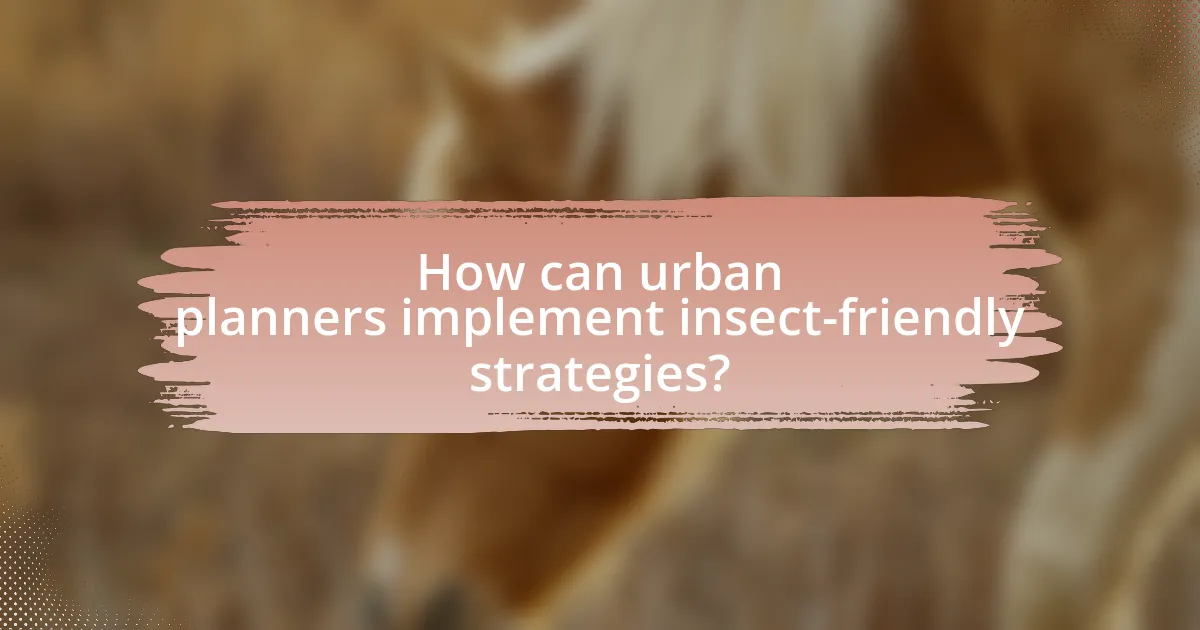
How can urban planners implement insect-friendly strategies?
Urban planners can implement insect-friendly strategies by incorporating native plant species into urban landscapes. Native plants provide essential habitats and food sources for local insect populations, which are crucial for pollination and maintaining biodiversity. Research indicates that urban areas with a higher diversity of native plants support greater insect diversity, as demonstrated in studies conducted by the University of Florida, which found that landscapes with native vegetation attract more pollinators compared to those dominated by non-native species. Additionally, urban planners can create green corridors and minimize pesticide use to further enhance insect habitats, promoting a healthier ecosystem within urban settings.
What specific design elements promote insect habitats?
Specific design elements that promote insect habitats include native plant landscaping, diverse plant species, water features, and undisturbed natural areas. Native plants provide essential food sources and shelter for local insect populations, while a variety of plant species supports different life stages and types of insects. Water features, such as ponds or rain gardens, offer hydration and breeding grounds for aquatic insects. Additionally, maintaining undisturbed natural areas allows insects to thrive without human interference. Research indicates that urban areas incorporating these elements can significantly enhance biodiversity, as demonstrated in studies showing increased insect populations in environments with native flora and diverse habitats.
How do native plants contribute to insect-friendly spaces?
Native plants contribute to insect-friendly spaces by providing essential food sources and habitats for various insect species. These plants are adapted to local ecosystems, offering nectar, pollen, and foliage that support pollinators like bees and butterflies, as well as herbivorous insects. Research indicates that gardens with native plants can support up to 50% more insect species compared to non-native gardens, enhancing biodiversity. Additionally, native plants often require less maintenance and fewer pesticides, creating a healthier environment for insects. This ecological compatibility fosters a balanced ecosystem, promoting the survival and reproduction of beneficial insects.
What features can be added to urban landscapes to attract pollinators?
To attract pollinators in urban landscapes, features such as native flowering plants, green roofs, and pollinator gardens can be added. Native flowering plants provide essential nectar and pollen sources that are specifically adapted to local pollinator species, enhancing their survival and reproduction. Green roofs can create additional habitats and food sources in densely populated areas, while pollinator gardens designed with a variety of flowering plants can support diverse pollinator populations. Research indicates that urban areas with increased floral diversity can significantly boost pollinator abundance and diversity, as demonstrated in studies conducted by the University of California, Berkeley, which found that urban gardens with native plants attracted three times more pollinators than those with non-native species.
How can community involvement enhance insect-friendly initiatives?
Community involvement enhances insect-friendly initiatives by fostering local engagement and promoting awareness of biodiversity. When communities participate in planning and implementing these initiatives, they contribute valuable local knowledge and resources, which can lead to more effective and tailored solutions. For instance, community-led projects such as pollinator gardens or native plant restoration not only increase habitat availability for insects but also educate residents about the importance of these species. Research indicates that areas with active community participation in environmental stewardship see a 30% increase in pollinator populations, demonstrating the direct impact of collective action on insect conservation.
What educational programs can raise awareness about insects in urban areas?
Educational programs that can raise awareness about insects in urban areas include community workshops, school curricula focused on entomology, and citizen science initiatives. Community workshops often involve hands-on activities that educate participants about local insect species and their ecological roles, fostering appreciation and understanding. School curricula that integrate entomology can enhance students’ knowledge of biodiversity and the importance of insects in ecosystems, with studies showing that such programs increase student engagement and awareness. Citizen science initiatives, like monitoring local insect populations, empower residents to contribute to scientific research while learning about insect conservation. These programs collectively promote awareness and appreciation of insects, essential for creating insect-friendly urban spaces.
How can local residents participate in creating insect-friendly spaces?
Local residents can participate in creating insect-friendly spaces by planting native flora, which provides essential habitats and food sources for various insect species. Research indicates that native plants support 50% more species of butterflies and moths compared to non-native plants, enhancing local biodiversity. Additionally, residents can reduce pesticide use, as chemicals can harm beneficial insects, and instead opt for organic gardening practices. Community initiatives, such as creating pollinator gardens or participating in local conservation programs, further engage residents in fostering environments that support insect populations. These actions collectively contribute to healthier ecosystems and promote sustainable urban living.
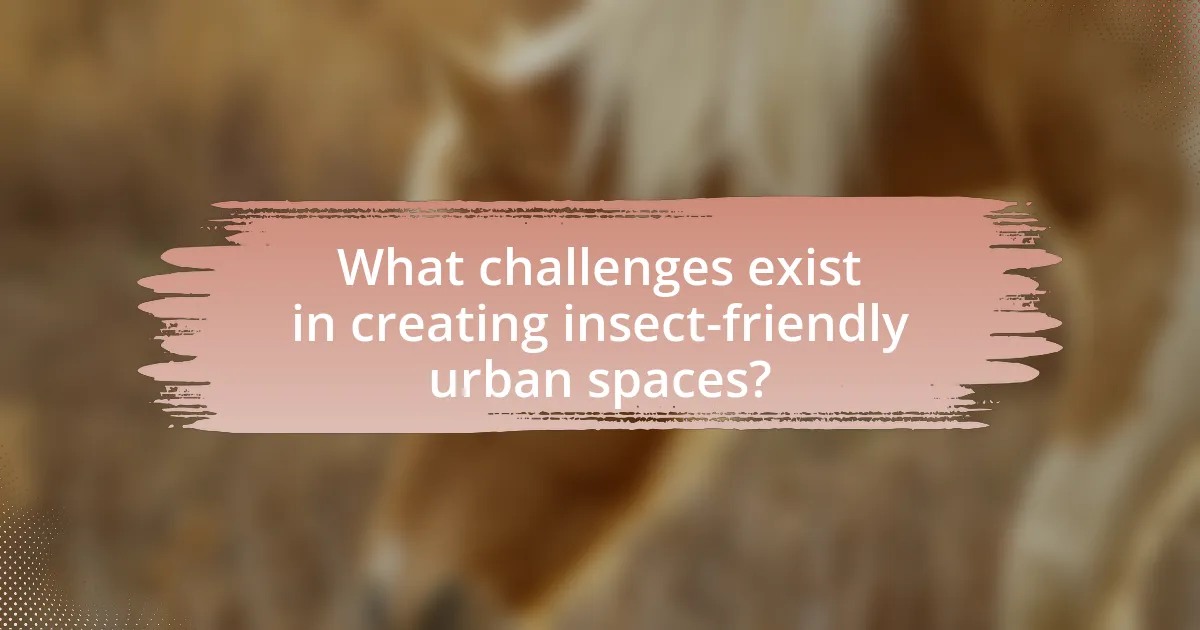
What challenges exist in creating insect-friendly urban spaces?
Creating insect-friendly urban spaces faces several challenges, including habitat loss, pesticide use, and urban design limitations. Habitat loss occurs as urban development replaces natural environments, reducing the availability of food and nesting sites for insects. Pesticide use in urban areas poses a significant threat, as chemicals intended for pest control can harm beneficial insect populations. Additionally, urban design often prioritizes aesthetics and functionality over biodiversity, leading to landscapes that lack the diverse plant species necessary to support various insect species. These challenges hinder efforts to promote insect-friendly environments in cities.
What are the common obstacles faced by urban planners?
Urban planners commonly face obstacles such as limited funding, regulatory constraints, and public opposition. Limited funding restricts the scope and scale of urban projects, making it difficult to implement comprehensive plans. Regulatory constraints, including zoning laws and environmental regulations, can hinder innovative design and development. Public opposition often arises from community concerns about changes to local landscapes, which can delay or derail planning efforts. These challenges are well-documented in urban planning literature, highlighting the need for effective stakeholder engagement and resource allocation to overcome them.
How can funding and resources impact the implementation of these strategies?
Funding and resources significantly influence the implementation of strategies for creating insect-friendly urban spaces by determining the scope and effectiveness of these initiatives. Adequate funding allows for the development of green infrastructure, such as pollinator gardens and native plant landscaping, which are essential for supporting insect populations. For instance, a study by the University of California found that cities investing in biodiversity projects saw a 30% increase in pollinator species. Additionally, resources such as expert personnel and educational materials enhance community engagement and awareness, leading to more successful adoption of insect-friendly practices. Without sufficient funding and resources, these strategies may be limited in scale and impact, ultimately hindering their effectiveness in promoting urban biodiversity.
What regulatory issues may hinder the creation of insect habitats?
Regulatory issues that may hinder the creation of insect habitats include zoning laws, pesticide regulations, and land use policies. Zoning laws can restrict the types of habitats that can be developed in urban areas, limiting the availability of suitable spaces for insects. Pesticide regulations may also pose challenges, as restrictions on certain chemicals can affect the management of habitats, potentially leading to conflicts between pest control and habitat preservation. Additionally, land use policies may prioritize development and urbanization over ecological considerations, further complicating efforts to establish insect-friendly environments.
How can these challenges be overcome?
To overcome challenges in creating insect-friendly urban spaces, cities can implement native plant landscaping, which supports local biodiversity. Research shows that native plants provide essential food and habitat for insects, leading to increased pollinator populations. Additionally, urban planners can establish green corridors and reduce pesticide use, which has been linked to declining insect populations. A study by the Royal Society for the Protection of Birds indicates that urban areas with more green spaces and fewer chemicals see a significant rise in insect diversity. By prioritizing these strategies, urban environments can effectively support insect populations and enhance ecological health.
What innovative solutions have been proposed to address these obstacles?
Innovative solutions proposed to address obstacles in creating insect-friendly urban spaces include the implementation of green roofs and vertical gardens, which provide habitats and food sources for various insect species. Research indicates that green roofs can support diverse insect populations, enhancing urban biodiversity. Additionally, the introduction of pollinator pathways, which are designed to connect fragmented habitats, has been shown to facilitate the movement of pollinators across urban landscapes. Studies highlight that these pathways can significantly increase pollinator visitation rates in urban gardens. Furthermore, community engagement initiatives that educate residents about the importance of insects and encourage native plant landscaping have been effective in fostering insect-friendly environments. Evidence from urban ecology projects demonstrates that such community-driven efforts can lead to increased awareness and participation in biodiversity conservation.
How can collaboration between stakeholders lead to successful outcomes?
Collaboration between stakeholders can lead to successful outcomes by pooling diverse expertise and resources, which enhances problem-solving capabilities. For instance, when urban planners, ecologists, and community members work together on creating insect-friendly urban spaces, they can integrate ecological knowledge with practical design, resulting in habitats that support biodiversity. Research indicates that collaborative projects, such as the “Urban Pollinator Project” in the UK, have successfully increased pollinator populations by 30% through stakeholder engagement, demonstrating that shared goals and combined efforts yield measurable ecological benefits.
What practical tips can be applied to create insect-friendly urban spaces?
To create insect-friendly urban spaces, incorporate native plants, which provide essential food and habitat for local insect species. Native plants are adapted to the local environment and support a diverse range of pollinators, such as bees and butterflies. Additionally, reduce pesticide use, as chemicals can harm beneficial insects and disrupt ecosystems. Implementing green roofs and community gardens can also enhance biodiversity by offering habitats and food sources. Research indicates that urban areas with diverse plant life can support higher insect populations, contributing to overall ecological health.
